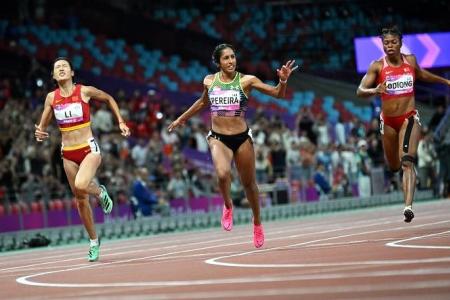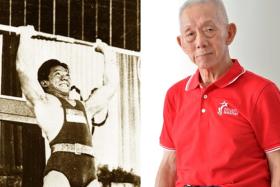Shanti Pereira’s booming slingshot for maximum impact
Sprinter Shanti Pereira explains how she draws speed round the bend
In biblical times, a boy named David defeated the giant Goliath with a slingshot. In recent times, Singapore sprint queen Shanti Pereira has been slaying her rivals with her own slingshot on the track.
Excitedly, the 200m specialist states that her favourite part of the race is when she exits the curve and “slingshots” into the straight.
“It’s like ‘boom!’, she says.
“If you exit the curve well with a good slingshot, you get that rev to move up a gear and you can feel that propulsion towards the finish line.”
Interestingly, men’s 200m world champion Noah Lyles also uses a motor racing analogy to describe his race. Likening it to Nascar, he says: “Coming around the turn, you’re trying to generate all that force and have that (imaginary) rope swing you around in a circle and whip you off the turn.
“You’re conserving energy, but you’re also generating more energy. If you do it right, you feel like you’re running down a hill. It feels like you’re weightless.”
After a period of stagnation and self-doubt, Pereira is running like a load has been lifted off her shoulders.
A seven-year drought occurred between her SEA Games golds in 2015 and 2022, but she has been unstoppable since, winning Asian Championships and Asiad golds.
Now 27, Pereira knows she cannot always be in a rush, because life is not always straightforward. Her pet event is a unique race that requires her to know how to negotiate a bend.
She explains: “You can’t run the 200m all out, you just cannot for the life of you run a 100m time on the curve. You need to pace it out a little bit.
“It is a longer event, the lactic acid kicks in towards the end, it involves endurance more than for the 100m, and there are strategies to the art of running the curve.”
On an oval track, 200m runners begin on a staggered start on the curve, exit on to the straight and dash towards the finish line.
For Pereira, her race strategy is geared towards making her slingshot as impactful as possible.
It starts with the deliberate placing of her starting blocks on the right side of her lane. Each lane width is 1.22m, and while running closer to the inside reduces the circumference one has to cover, the angle of the curve can be tighter and tougher to navigate on the inner-most lanes.
She says: “My block is positioned towards the outer part of my lane, and I cut towards the inside on the left.
“I like to do this at the start because it gives the illusion of a straighter line, and if you’re running a straight line, you run faster compared to running on a curve. So, I try to manipulate this in a way to try and cut down the time, as every millisecond counts.”
Like many top sprinters, Pereira wants to be fast off the blocks and attack the first 30 metres.
But while some sprinters like to tilt their head or lean towards the inside while they are on the curve, Pereira prefers to keep hers upright and her body in a neutral position to avoid expending extra energy.
The challenge is to “stay aggressive but relaxed” to have enough reserves to exit the bend for a final 90m burst.
A good curve run is not just a good feeling.
“It can make a significant difference of 0.1 second, take you to the front of the pack or closer to whoever is leading, and help you win a medal or the race.”
It is also hard to replicate, but that does not stop her from hitting the gym to strengthen her ankles, arm swings, core, glutes, hamstrings, and quads, and clocking 120m, 150m and 300m repetitions under the watchful eye of her coach Luis Cunha.
They also look at her running mechanics to make sure she maintains a good form – with her knee positioned in front of her ankle throughout – despite fatigue.
On average, she has reduced her front 100m times from 12.1 in 2022 to 11.8 in 2023, and also gone faster in the final stretch from 11.5 to 10.9.
Her goal is to become the first Singaporean woman to progress to an Olympic semi-final.
Ahead of Paris 2024, she was devastated to miss her Diamond League debut because of a leg injury in April. Now fully recovered, she says: “You can compare the 200m curve to life in the sense there are parts where you need to negotiate, strategise, and pace yourself to have enough in the tank to make that final push.
“I now accept this is a part of the journey.”
Get The New Paper on your phone with the free TNP app. Download from the Apple App Store or Google Play Store now


